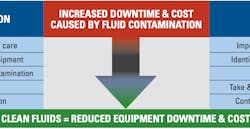Left unchecked, fluid contamination assaults components to the point where, with little to no warning, the system fails, causing immediate chaos. Operators and site managers quickly contact maintenance, demanding immediate dispatch of a technician. Maintenance managers examine the work schedule to identify a technician working on a machine of lesser demand who they can immediately dispatch to the failed machine. A backlog of work builds up in the maintenance schedule. In addition, cost estimates escalate two-fold as managers deploy secondary equipment and failure-repair cost increases the overall machine cost.
For more asset management.
A sound fluid contamination prevention and mitigation strategy will result in decreased failures and an overall cost-effective and productive work environment. Developing a successful and sustained strategy requires full support from the executive branch and a team from all maintenance and operational areas of the organization.
The team must identify all the various sources of fluid contamination to strategically address countermeasures mitigating potential fluid contamination and failures. It must clearly identify steps and measures to prevent fluid contamination as well as mitigate existing fluid contamination. The plan should also address training and awareness on the types of fluids required by the fleet, the potential sources of contamination, prevention/mitigation measures, and reasons for a sustained effort.
Contamination occurs when an impurity that infects the natural environment of equipment components and systems enters the base fluid. Solid contaminates such as dirt create an abrasive content within the fluid that attacks wear surfaces and restricts fluid flow. Liquid contaminates such as water alter a fluid’s ability to properly lubricate internal wear surfaces. In some instances, chemical reactions caused by contamination create high acidic levels chemically attacking seals, wear surfaces, and other internal components.
Maintenance and operator care functions account for approximately 90 percent of fluid contamination. As personnel open specific equipment systems, they expose those systems to the elements and create a significant potential for the introduction of solids, liquids, or airborne particulate contamination.
Storage, transfer equipment, and the delivery method of fluids also have a high potential to contaminate fluids. Improper seals on bulk containers introduce solid and liquid contaminates and allow them to collect within the containers. Transfer systems can hold contaminates introduced from bulk tanks, slowly releasing them as fluids move through the system. Smaller containers normally utilized as the delivery method by field operators as top-off fluids also have high potential to contaminate a specific compartment.
The equipment manufacturing process itself introduces contamination as microscopic solids or liquids could remain within specific components, contaminating the fluids added during assembly.
New or virgin fluids often arrive from the manufacturing plant to regional distribution centers via bulk container transport. They then move to on-site containers of various sizes, increasing the possibility of contamination.
Cross-compartmental contamination, normally a secondary result of another impending issue, allows fluids to pass through degraded seals or gaskets into the adjoining compartment. It can also occur when various machines share hydraulically powered tools and attachments.
Fluid contamination prevention strategy
First and foremost, use a robust fluid analysis program for proper fluid condition monitoring and documentation. All new and virgin fluids should be sampled to validate product accuracy and cleanliness. Sampling should occur at variable intervals within the preventive maintenance program, and immediately upon identification of a potential defect between PM cycles.
Machines and equipment should be properly cleaned prior to PM service or repair. Operators should always clean fluid access points prior to opening for top offs. Lubrication points (zerks) should be capped and always wiped clean prior to connection to lube equipment.
Fluid contamination assaults components to the point where, with little warning, the system fails, causing immediate chaos.
Bulk storage containers and subsequent delivery systems—fixed or mobile—require routine fluid monitoring as fluctuations in ambient air temperature create condensation within the container. Transport/delivery containers utilized by staff for field service work and top off should be well sealed and properly labeled with the specific fluid contained. They should be stored and kept from exposure to open air environments where contaminates will collect upon them. These containers should be single use/disposable/recyclable only. If reused, they should only be utilized for the labeled fluid. They must be cleaned prior to refilling and immediately sealed. Parts and materials management staff should control storage, issuance, and refilling of such containers for reduced contamination potential as well as inventory control.
Fluids in new equipment should be changed or filtered with an external filtering system within 10 hours of operation to remove manufacturing contaminants. At the same time, change all filters.
Require suppliers to filter all bulk fluids when delivered and transferred to bulk containers. All bulk fluids should be filtered upon being dispensed to machines and equipment, or to smaller transportable containers.
Require routine fluid analysis to identify the source of cross-compartmental contamination and all affected compartments. Each compartment should be cleaned, filtered, and re-sampled before returning the machine to service. Increasing the cleanliness and quality of fluids utilized within the fleet can allow for broader usage and be a significant factor in reducing cross-contamination.
Hydraulically powered tools and attachments should not be shared between various machines. If they are, require a fluid filtering system to filter fluids of contamination prior to connection with an alternate machine.
Training staff on proper contamination control methods will maximize mitigation of all types of fluid contamination. Require all maintenance staff, supervisors, technicians, lube technicians, fuelers, and operators to attend and complete contamination control training. Include such training within the organization’s technician development plan and require it each year.
Successful contamination prevention and mitigation training should include:
- The reason the organization has developed an in-depth contamination mitigation plan.
- How to identify the proper fluids for specific compartments on the various types of equipment.
- How to fill and lubricate to the proper level and amount.
- The contaminates and their potential sources.
- How to accurately take fluid samples, and how to read and understand a fluid analysis report.
- The steps and measures required of all staff to remove or mitigate contamination.
- The review mechanism to add or delete new or obsolete controls.
Successful equipment managers understand how fluid contamination affects unscheduled downtime and costs. They maintain a constant vigil on potential types and sources of contamination within their fleets, and constantly train and re-train staff on prevention and mitigation measures. In doing so, they increase utilization and decrease the cost of the equipment fleet.







